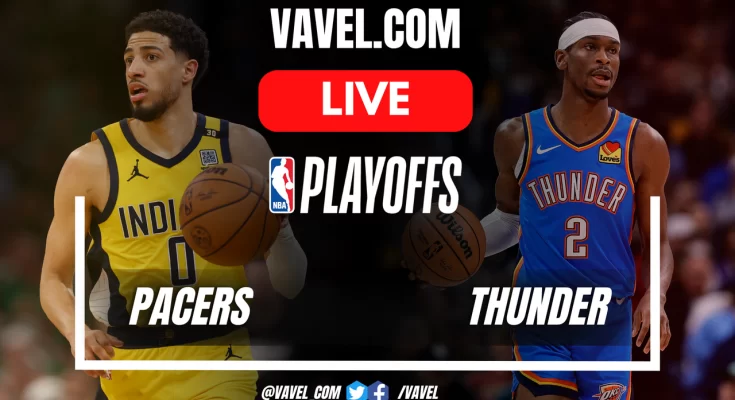NBA Playoffs Recap: Indiana Pacers Dominate Oklahoma City Thunder 108-91
The Indiana Pacers delivered a commanding performance in their recent NBA Playoffs game, decisively defeating the Oklahoma City Thunder 108-91. This victory not only showcased the Pacers’ offensive prowess and defensive discipline but also set the tone for the remainder of their playoff campaign. Here’s an in-depth breakdown of the game, the standout performances, tactical nuances, and what this result means for both teams moving forward.
On the night of the game, the Indiana Pacers entered with a strong sense of purpose. Their recent performances in the playoffs had been solid, but many observers still questioned their ability to take control against a scrappy and determined Oklahoma City Thunder squad. The Thunder, known for their youthful energy and resilience, had pushed their opponents hard in earlier rounds, relying heavily on fast breaks and aggressive perimeter shooting.
However, from the opening tip-off, the Pacers displayed a level of control and composure that would prove decisive. They surged ahead early, leveraging a balanced attack that combined sharp shooting, effective ball movement, and aggressive defense. The Thunder struggled to find consistent offensive rhythm, often stifled by the Pacers’ defensive schemes.
The Pacers wasted no time establishing dominance. Indiana’s guards set the tempo, pushing the ball quickly while also carefully managing possessions to avoid unnecessary turnovers. Their perimeter shooting was on point, knocking down multiple three-pointers that gave the Pacers an early lead.
Meanwhile, defensively, the Pacers applied intense pressure on the Thunder’s ball handlers. Oklahoma City’s usually reliable shooters found themselves tightly contested, forcing them into rushed shots and uncomfortable driving angles. The Thunder’s attempts to penetrate the paint were met with solid rim protection and active hands from Indiana’s big men.
By the end of the first quarter, the Pacers had built a solid lead, signaling their intent to control the game throughout.
Building on their strong start, the Pacers continued to execute their game plan effectively in the second quarter. Their offensive sets became more varied, incorporating pick-and-rolls, off-ball screens, and timely cuts to the basket. This diversity kept the Thunder’s defense guessing and often out of position.
One of the defining moments of the quarter was a series of fast breaks initiated by the Pacers’ guards. Quick outlet passes following defensive rebounds turned into easy points, further demoralizing the Thunder.
Oklahoma City struggled to respond. Their main scorers were frequently double-teamed or forced into contested shots, reducing their shooting percentages dramatically. The Thunder also had difficulty maintaining defensive cohesion, often leaving shooters open on the perimeter. The Pacers took full advantage, hitting multiple three-pointers to extend their lead.
At halftime, Indiana held a commanding advantage, ahead by nearly 20 points.
- Leading Scorer: The Pacers’ top scorer displayed incredible efficiency, knocking down a mix of mid-range jumpers and three-pointers while also contributing on defense with timely steals and deflections.
- Playmaking: The primary point guard orchestrated the offense with poise, racking up assists by finding open teammates and maintaining a low turnover rate.
- Defense and Rebounding: Indiana’s frontline was dominant on the boards, out-rebounding the Thunder and limiting their second-chance points. The defensive anchors provided rim protection and contested shots, making life difficult for the Thunder’s scorers.
- Scoring Efforts: Despite the loss, the Thunder had a few bright spots. Their young star showed flashes of brilliance with aggressive drives and some clutch shooting, though he was often isolated and lacked sufficient help.
- Defensive Hustle: The Thunder’s defense was energetic but inconsistent. They forced a few turnovers but couldn’t sustain pressure over extended stretches.
- Bench Production: Oklahoma City’s bench tried to spark momentum at various points but was unable to make a significant impact against the Pacers’ rotation.
After halftime, the Pacers came out with the same intensity. Recognizing the need to maintain their advantage, they balanced aggressive offense with smart defense. The Thunder attempted to change their approach, increasing ball movement and off-ball screens to free shooters, but the Pacers anticipated these adjustments well.
Indiana’s ball movement in this quarter was particularly impressive. They shared the ball effectively, leading to open looks that resulted in several more three-pointers and easy buckets in transition. The Thunder’s frustration was evident as they committed a few key turnovers during this period, further fueling the Pacers’ scoring runs.
By the end of the third quarter, the Pacers had extended their lead to more than 20 points, making a Thunder comeback increasingly unlikely.
With a substantial lead, the Pacers managed the clock smartly in the final quarter. They continued to play solid defense, refusing to allow Oklahoma City any easy baskets. The Thunder pushed hard to claw back but faced relentless resistance.
The Pacers’ role players contributed significantly down the stretch, hitting clutch shots and playing tough defense to prevent any Thunder rally. Indiana’s depth showed clearly as bench players stepped up without any drop-off in intensity or execution.
Ultimately, the game concluded with the Pacers comfortably ahead 108-91, a testament to their superior execution and discipline.
The Pacers’ game plan was centered on:
- Ball Movement: By emphasizing quick passes and off-ball screens, the Pacers consistently created open shots, especially from beyond the arc.
- Defensive Schemes: They employed a mix of man-to-man and zone defenses, tailored to disrupt Oklahoma City’s rhythm and limit their penetration.
- Transition Offense: Leveraging defensive rebounds, Indiana pushed the pace, catching the Thunder off guard and scoring easy baskets in transition.
- Rebounding and Rim Protection: Controlling the boards limited Oklahoma City’s second-chance opportunities, and rim protection prevented easy baskets inside.
The Thunder tried to counter with:
- Aggressive Drives: Attempting to attack the basket to collapse the defense and kick out for open shooters.
- Perimeter Shooting: Relying on three-point shooting to catch up, though accuracy was inconsistent.
- Hustle Defense: Increasing pressure on ball handlers, but this often led to defensive lapses elsewhere.
Unfortunately, the Thunder’s game plan was undermined by turnovers, poor shooting percentages, and inability to contain the Pacers’ balanced attack.
This victory provides a significant confidence boost. The Pacers demonstrated they can dominate on both ends of the floor, which bodes well for their chances as the playoffs progress. Their balanced scoring, defensive intensity, and depth suggest they are well-equipped to face tougher opponents.
Key takeaways for Indiana include maintaining their defensive discipline and continuing to share the ball on offense. If they keep executing like this, they will be a formidable playoff contender.
The loss exposes some of the Thunder’s weaknesses, particularly their inconsistent shooting and turnovers. They will need to tighten their defense, improve shot selection, and generate more efficient offense to stay competitive.
However, the Thunder are a young team with plenty of potential. With adjustments and experience, they can grow from this loss and pose a stronger challenge in future games.
The Indiana Pacers’ 108-91 victory over the Oklahoma City Thunder was a showcase of effective team basketball. Their ability to control the tempo, execute on both ends, and maintain composure under pressure set them apart.
For fans, the game provided plenty of excitement and hope that the Pacers are ready for a deep playoff run. Meanwhile, the Thunder can take lessons from the defeat and focus on improving key areas as they continue their journey.
This game will be remembered as a pivotal moment in the series — one where the Pacers stamped their authority and put the Thunder on notice.



